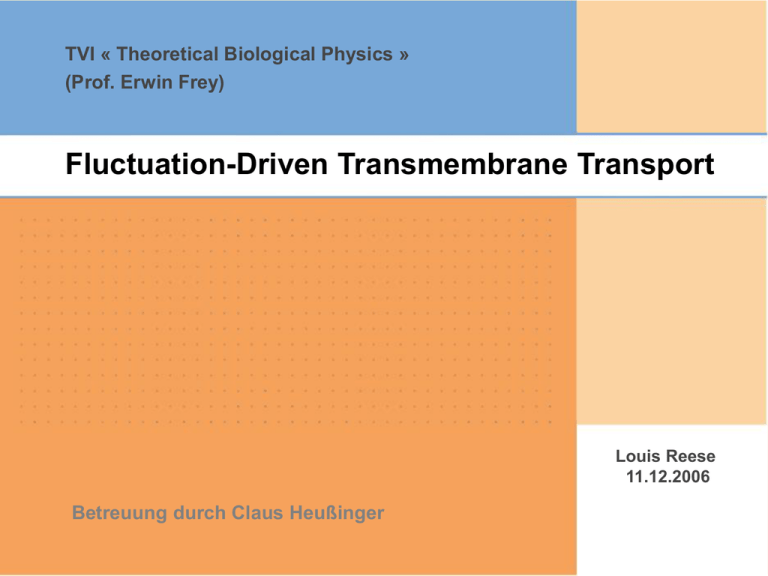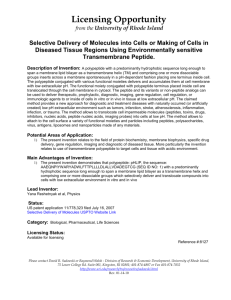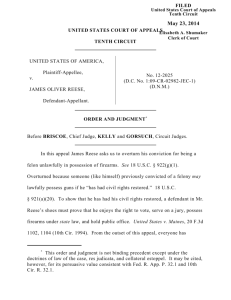Protein Fluorescence
advertisement

TVI « Theoretical Biological Physics » (Prof. Erwin Frey) Fluctuation-Driven Transmembrane Transport Louis Reese 11.12.2006 Betreuung durch Claus Heußinger Protein Fluorescence Outline 1. The Cell Membrane • • Protein activity in the Plasma Membrane Transport Through Membranes 2. Transport due to Fluctuations • • • Modelling a Channel Protein Developing a Theoretical Model Solutions of the Fokker-Planck Equation 3. Outlook Fluctuation-Driven Transmembrane Transport Louis Reese Motivation Hydrophobic barrier Protein Fluorescence The Cell Membrane Lipid bilayer Membrane maintains concentrations of solutes hydrophilic Hydrophobic Molecules (O2, CO2) Small molecules, polar, uncharged (H2O, glycerol) hydrophobic Large molecules, polar, uncharged (glucose) Ions (H+, Na+, K+, …) Storage of Potential Energy Fluctuation-Driven Transmembrane Transport Louis Reese Motivation Membrane Activity Protein Fluorescence The Plasma Membrane Plasma Membrane Cytosol Cell Boundary Ingest nutrients Excrete metabolic waste Membraneous Cell Compartments Ion gradients provide energy for • ATP Synthese • Transport mechanisms We need machines to perform these tasks: Membrane Proteins • Electrical signals Fluctuation-Driven Transmembrane Transport Louis Reese Motivation Protein Functions Protein Fluorescence Membrane Proteins • ~30% of Genes (animals) encode Membrane Proteins • Membrane Proteins ~50% of the membrane mass Transporter Sensors/Receptors (external Signals) Membrane associated Reactions Connection to Cytoskeleton Are supposed to be responsible for Nonequilibrium Fluctuations A. E. Pelling, et al. (2004) Fluctuation-Driven Transmembrane Transport Louis Reese Motivation Transmembrane Transport Transport Through the Membrane • Functional Proteins asure selectivity Active Pumping « Uphill » Coupled to catalysing energy-source (Light, ATP, coupled-Carriers) Passive Facilitated Diffusion « Downhill » the Concentration gradient We’ll see soon that there are posibillities to make these Channels « WORK » Fluctuation-Driven Transmembrane Transport Louis Reese Protein Fluorescence Theoretical Model Molecular Restraints Protein Fluorescence Transport due to Fluctuations • The Glycerol uptake Facilitator (GlpF) Needed, but poisons the cell at high concentrations. Na+ Sugar Molecule Pulling X-Ray Structure shows Selectivity Molecular Dynamics: Asymmetric Potential of Mean Force (PMF) M. Ø. Jensen, et al. (2002) Fluctuation-Driven Transmembrane Transport Finally a realistic Potential! Louis Reese Theoretical Model Equation of Motion Protein Fluorescence Modelling Transport • Brownian Motion: The Langevin Equation Virtual Friction Virtual Realistic Potential of Mean Force LangevinForce: White Noise Fluctuation-Driven Transmembrane Transport Louis Reese Membrane FluctuationForce Theoretical Model Transport FPE Protein Fluorescence Modelling the Transport Protein Probability densities Fokker-Planck Equation Fluctuation-Driven Transmembrane Transport Louis Reese Theoretical Model Transport Flux Protein Fluorescence Details of Molecular Flux • Composition of Flux through Channel Diffusion Acting Forces Asymmetric Protein Potential + Membrane Fluctuation We know already: Zero-Force & Constant-Force Fluctuation-Driven Transmembrane Transport Louis Reese Results Outward Flux Periodic Force Protein Fluorescence Transport enhenced by external Force • Periodic Force in Despite Force: High Barrier out out in Fluctuation-Driven Transmembrane Transport Asymmetric Potential Outward Transport Louis Reese Results Outward Flux Random Force Protein Fluorescence Transport driven by Random-Telegraph-Force • Fluctuating Force Poisson Mean Switching Time We still expect outward flux being better than inward flux. But 2 more Questions arise: 1. How do switching times influence transport? 2. Which role plays the concentration gradient? Fluctuation-Driven Transmembrane Transport Louis Reese Results Switching Time Tunes Transport Protein Fluorescence Switching Times tune Transport • Switching very fast ~10-9s does not influence flux. • Switching slowly ~10-2s, the time-dependence vanishes In between, at equal concentrations: ? Fluctuation-Driven Transmembrane Transport Louis Reese Results Concentration Gradient Regulates outward Transport Protein Fluorescence Concentration Gradient Regulates outward Transport • Current reversal depends on concentration gradient. The passive Protein finally « WORKS » ! Fluctuation-Driven Transmembrane Transport Louis Reese Outlook Biology Physics Protein Fluorescence Outlook • Biological: Membrane Fluctuations could play a role in Cellular Transport Mechanisms – Protection against poisoning – Enhence nutrient uptake • Theoretical Physics: Insight into processes spanning a timescale – From bottom-up simulations (~10-9s) to – Fluctuations (µs) to – Genetic mechanisms (~minutes) Fluctuation-Driven Transmembrane Transport Louis Reese Protein Fluorescence Take-Home Message • Membranes – Make the difference between Life and Environment. • Proteins – Are active or passive transporters – Molecular structure/symmetries are crucial! • Membrane Fluctuations – Influence protein-transport properties! – Could be a hidden energy source Fluctuation-Driven Transmembrane Transport Louis Reese Protein Fluorescence Thank you for your attention! Fluctuation-Driven Transmembrane Transport Louis Reese Appendix Protein Fluorescence Bibliography Results: I.Kosztin, K. Schulten, PRL 93, 238102, 2004 Additional Material: B. Alberts et al., Molecular Biology of the Cell, (2002) 4th ed. M. Ø. Jensen, et al., PNAS 99, 6731 (2002) Homepage of Klaus Schulten. Previous Seminar Talks: „Forced thermal Ratchets“ „Fluctuation Driven Ratchets: Molecular Motors“ Fluctuation-Driven Transmembrane Transport Louis Reese






